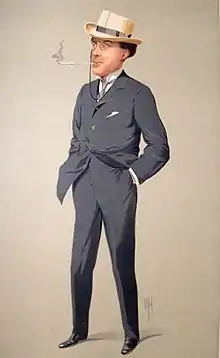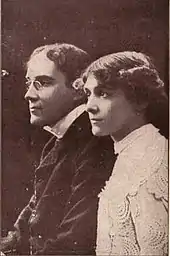Laurence Irving (dramatist)
Laurence Sydney Brodribb Irving (21 December 1871 – 29 May 1914)[1] was an English dramatist and actor. He died along with his wife in the RMS Empress of Ireland disaster.

Life and career
Born in London, Laurence Irving was a son of the great Victorian actor-manager, Sir Henry Irving and his wife Florence (née O'Callaghan), and brother to actor manager Harry Brodribb Irving. He was educated at Marlborough College and the College Rollin in Paris, following which he was in Russia for three years studying for the Foreign Office. However, instead he took up acting, making his first appearance in 1891[2] as Snug in The Dream in F. R. Benson's theatrical company - not counting childhood performances.[3] In 1892 he appeared at Toole's Theatre in Daisy's Escape, and after a time toured as Svengali in Trilby. In 1898 he then joined his father's Company at the Lyceum Theatre taking minor roles or juvenile leads as in Peter the Great (1898), Robespierre (1899), as Courriol in The Lyons Mail (1900), Coriolanus (1900–01), Dante (1902–03), Much Ado About Nothing (1904–05), and as Nemours in Louis Xl. Robespierre was his own translation from the French of Victorien Sardou, as also was Dante, in which his father acted.[2][4]
Soon after he became an actor-manager starring with his own Company, playing the title role in Hamlet. He adapted Dostoevsky's Crime and Punishment into The Unwritten Law and just before sailing for the United States and Canada in 1912 he made a success in London with his own adaptation from the Hungarian of a Japanese subject entitled The Typhoon. A topical play set in the time of the Russo-Japanese War, with Irving playing a Japanese officer, it was first produced by him at the Haymarket Theatre in April 1912 before taking it on a tour of the provinces.[5] His talents as an actor were recognised in his portrayal of the crafty old Nikolas Arnesson, Bishop of Oslo in Ibsen's tragedy The Pretenders at the Haymarket.[2] He was Iago in a production of Othello at His Majesty's Theatre.[4]
Irving was also a dramatist,[6] his stage plays including Robespierre (1899), Richard Lovelace (1901), Dante (1903), The Fool Hath Said: There Is No God (1908), The Incubus (1909), The Affinity (1910), and The Three Daughters Of Monsieur Dupont (1910). Due to the financial failure of his play Dante his father was forced to sell the Lyceum Theatre, London. Irving was married to a fellow performer, actress Mabel Lucy Hackney (1872–1914).
Laurence and Mabel were on a tour of first Australia and then North America from 1912 to 1914. Their biggest success on the tour was Laurence's own play The Typhoon.
Death

At the end of the tour they were returning home when Laurence and Mabel Irving drowned in the RMS Empress of Ireland disaster on 29 May 1914 when in the early hours of the Empress of Ireland was rammed by the Storstad, a Norwegian collier, on her starboard bow. Storstad remained afloat, but Empress of Ireland was severely damaged. A gaping hole in her side caused the lower decks to flood at a rate alarming to the crew. Empress of Ireland lurched heavily to starboard. Most of the passengers and crew located in the lower decks drowned quickly and water entered through open portholes, some only a few feet above the water line, and inundated passageways and cabins. Those berthed in the upper decks were awakened by the collision, and immediately boarded lifeboats on the boat deck. Within a few minutes of the collision, the list was so severe that the port lifeboats could not be launched. Some passengers attempted to do so but the lifeboats just crashed into the side of the ship, spilling their occupants into the frigid water. Five starboard lifeboats were launched successfully, while a sixth capsized during lowering.[7]

Ten or eleven minutes after the collision, Empress of Ireland lurched violently onto her starboard side, allowing as many as 700 passengers and crew to crawl out of the portholes and decks onto her port side. The ship lay on her side for a minute or two, having seemingly run aground. A few minutes later at 02:10, about 14 minutes after the collision, the bow rose briefly out of the water and the ship finally sank. Hundreds of people were thrown into the near-freezing water. The disaster resulted in the deaths of 1,012 people.
Reports in the news accounts of the tragedy say that Laurence Irving and Mabel Hackney got separated and Irving was in a position of temporary safety but he knew Mabel could not swim and he jumped back into the St. Lawrence River to rescue her. Their bodies were never found.
See also
References
- Chisholm, Hugh, ed. (1922). . Encyclopædia Britannica (12th ed.). London & New York: The Encyclopædia Britannica Company.
- Phyllis Hartnoll and Peter Found, Laurence Sidney Brodribb Irving (1871–1914) - The Concise Oxford Companion to the Theatre, (2 ed.), Oxford University Press, Print Publication Date: 1996 Print ISBN 9780192825742 Published online: 2003
- "Music and the Drama: Irving's Visit". The Week : a Canadian journal of politics, literature, science and arts. 1 (13): 205. 28 February 1884. Retrieved 27 April 2013.
- 'Late Mr Laurence Irving: Empress of Ireland Victim' - The Cairns Post (Queensland, Australia: 1909-1954), 16 June 1914, Page 2
- The Typhoon (1912) - Theatricalia website
- Vanity Fair magazine 'Men Of The Day' (1912)
- "Report and Evidence of the Commission of Enquiry into the Loss of the British Steamship "Empress of Ireland" of Liverpool (0. No. 123972) Through Collision With the Norwegian Steamship "Storstad." Quebec, June, 1914". Sessional Papers of the Parliament of the Dominion of Canada. Ottawa: J. de L. Tache. 16: Fifth session of Twelfth Parliament, Vol.L (No.21b–1915). 1914. Retrieved 5 December 2015.
- Report reprinted in the UK as command paper Cd. 7609 (HMSO 1914), p. 19.
- Holroyd, Michael (2008): A Strange Eventful History; The Dramatic Lives of Ellen Terry, Henry Irving and their Remarkable Families; Pub. Chatto & Windus ISBN 9780701179878
Bibliography
- Godefroi and Yolande: A medieval play in one act (1894)
- "Much Ado About Nothing" (1905)
- Typhoon (1913)
External links
| Wikimedia Commons has media related to Laurence Irving. |